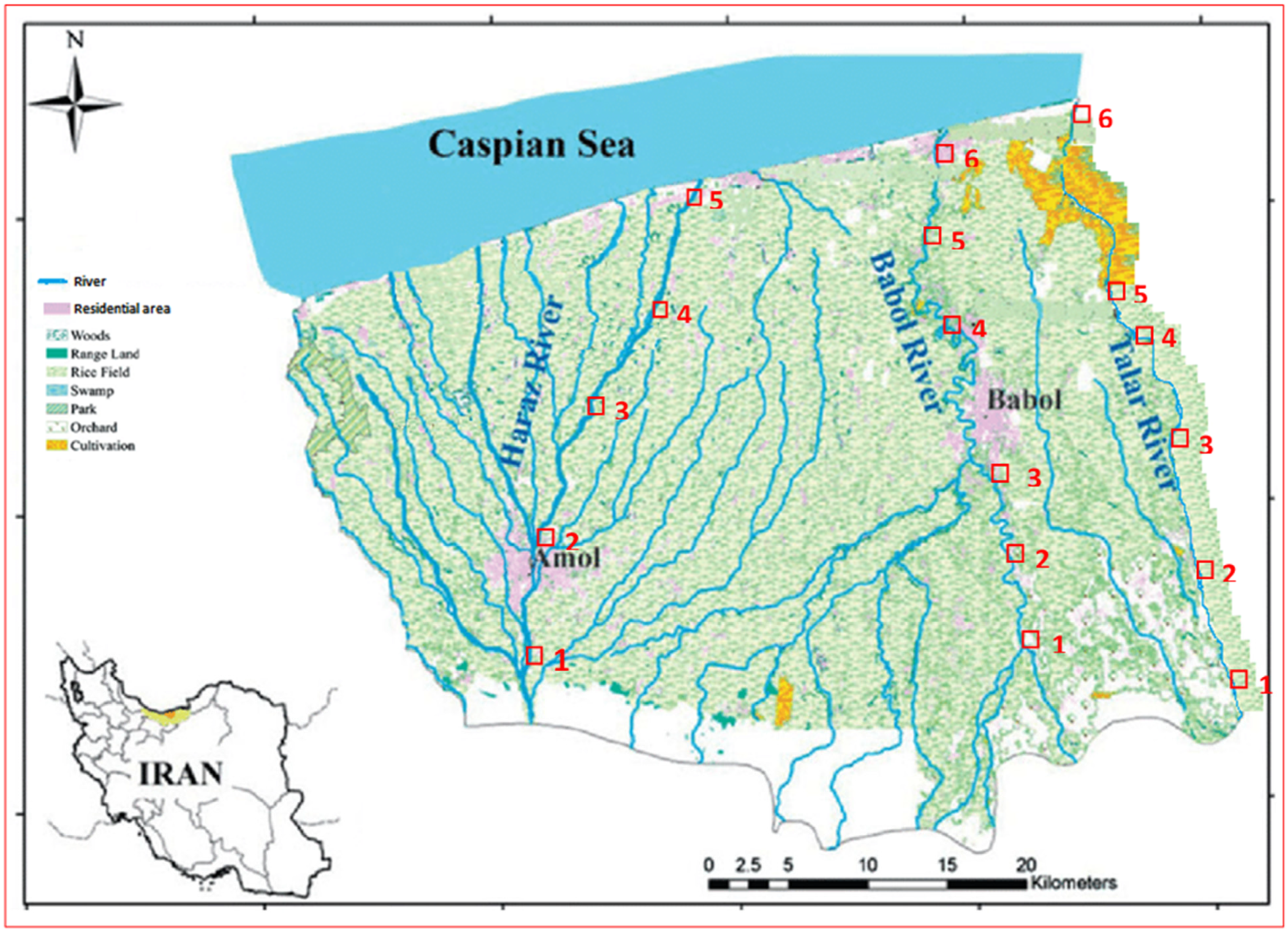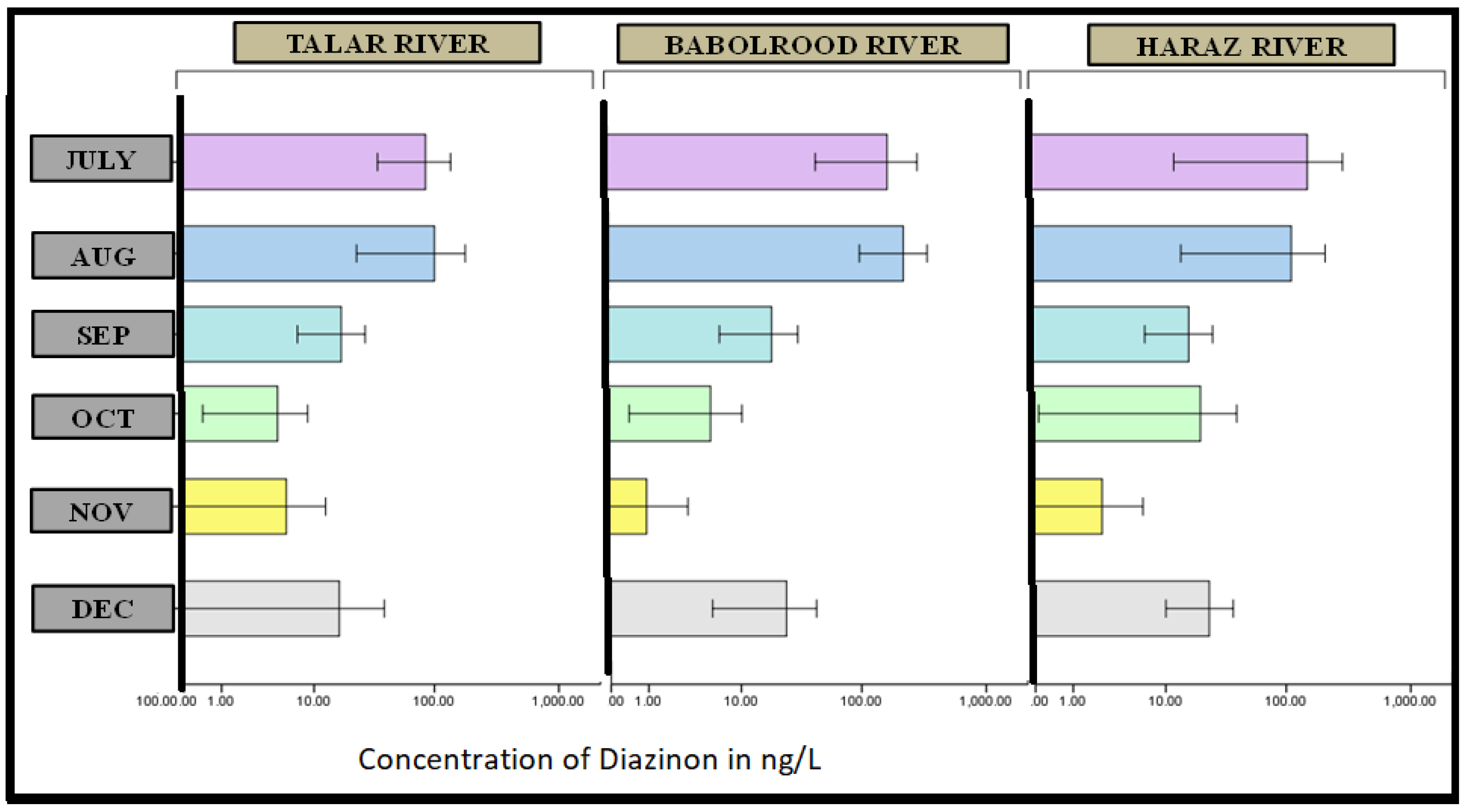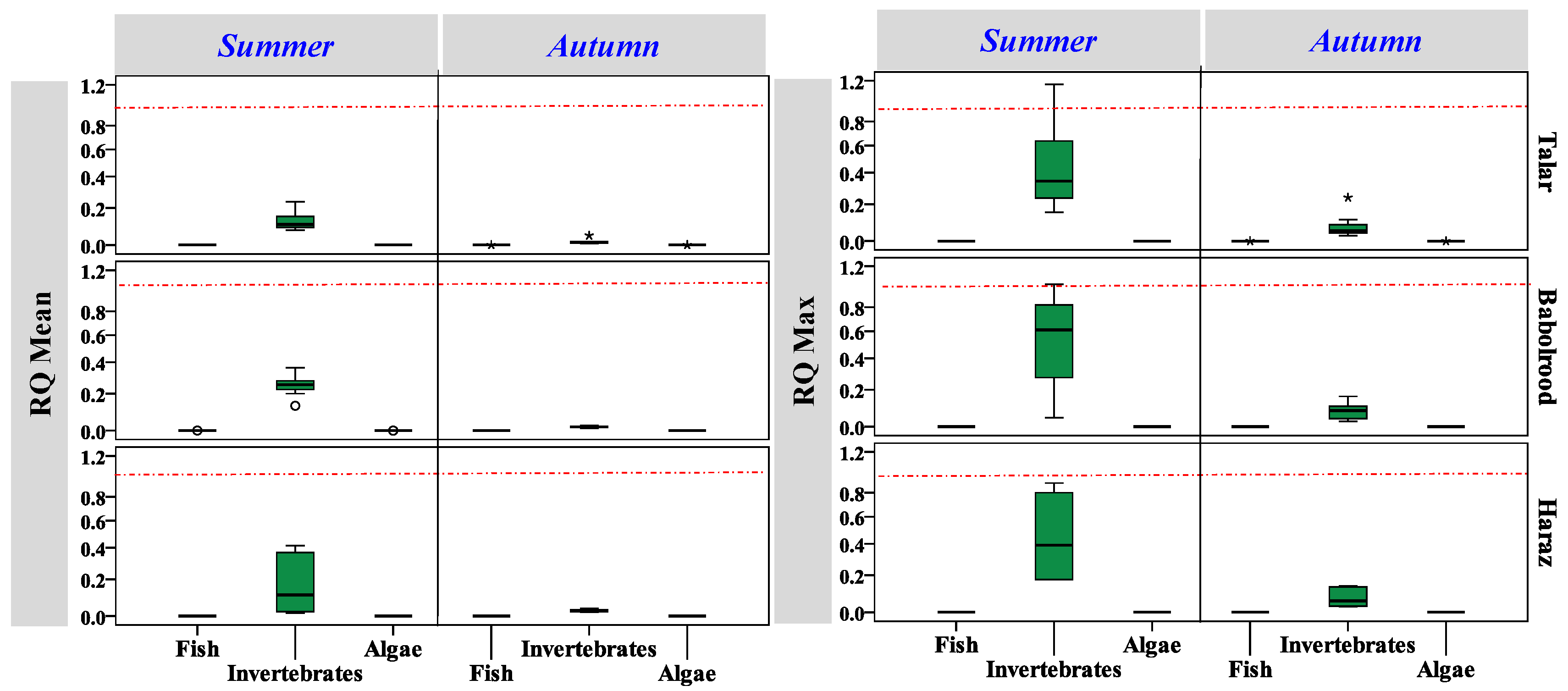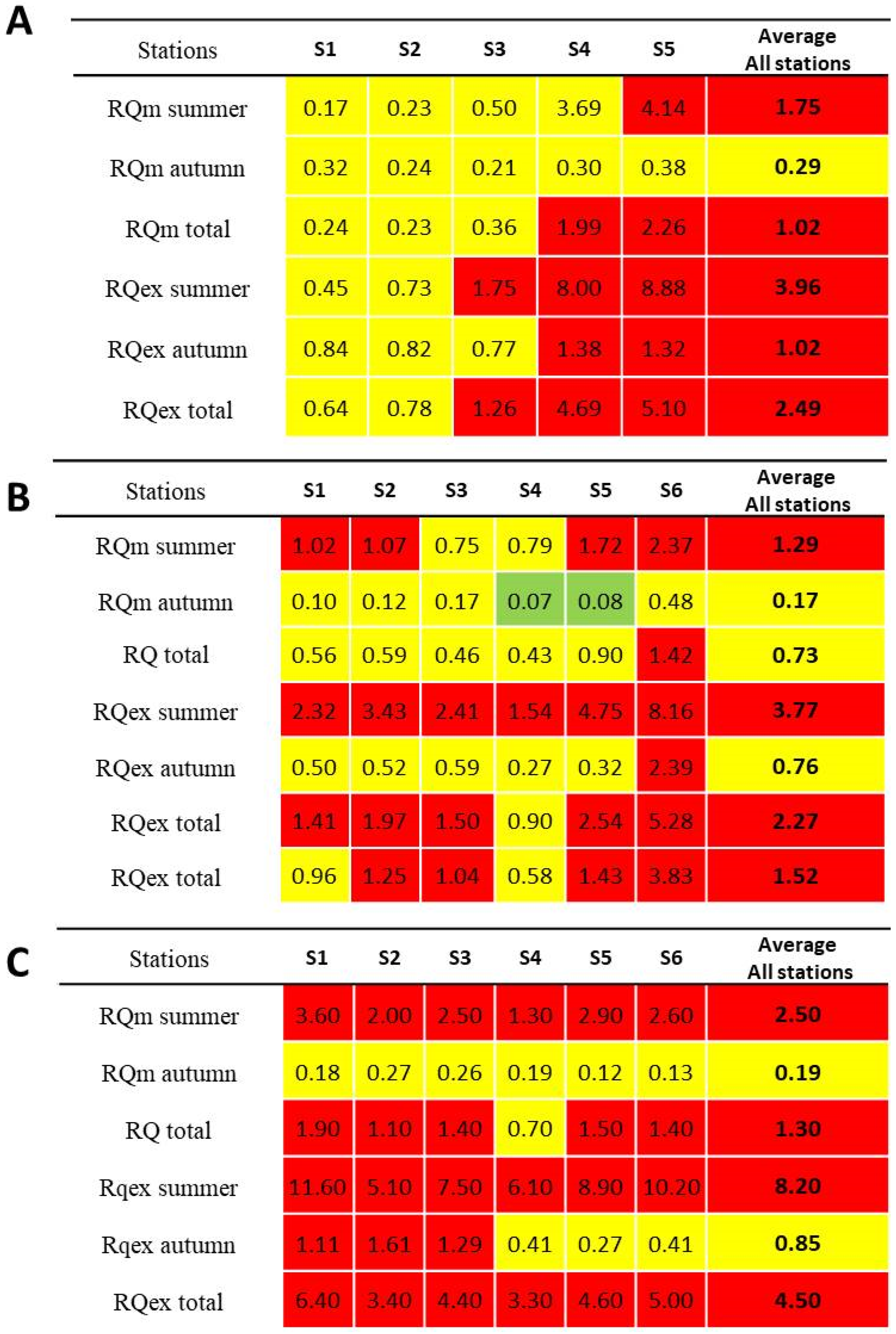Assessing Diazinon Pollution in the Three Major Rivers Flowing into the Caspian Sea (Iran)
Abstract
:1. Introduction
2. Material and Methods
2.1. Locations of Sampling Stations
2.2. Collection of Samples
2.3. Analytical Procedures, Quantification and Quality Assurance
2.4. Aquatic Risk Assessment
2.5. Statistical Analysis
3. Results and Discussion
3.1. Seasonal and Spatial Distribution of Diazinon in the Talar, Babolrood and Haraz Rivers
3.2. Risk Assessment
3.3. International Quality Standards for Diazinon
4. Conclusions
Author Contributions
Funding
Institutional Review Board Statement
Informed Consent Statement
Data Availability Statement
Acknowledgments
Conflicts of Interest
References
- Alavanja, M.C.R. Pesticides use and exposure extensive worldwide. Rev. Environ. Health 2009, 24, 303–309. [Google Scholar] [CrossRef] [PubMed]
- Wee, S.Y.; Aris, A.Z. Ecological risk estimation of organophosphorus pesticides in riverine ecosystems. Chemosphere 2017, 188, 575–581. [Google Scholar] [CrossRef] [PubMed]
- López-Blanco, C.; Gómez-Álvarez, S.; Rey-Garrote, M.; Cancho-Grande, B.; Simal-Gándara, J. Determination of carbamates and organophosphorus pesticides by SDME—GC in natural water. Anal. Bioanal. Chem. 2005, 383, 557–561. [Google Scholar] [CrossRef] [PubMed]
- Zheng, S.; Chen, B.; Qiu, X.; Chen, M.; Ma, Z.; Yu, X. Distribution and risk assessment of 82 pesticides in Jiulong River and estuary in South China. Chemosphere 2016, 144, 1177–1192. [Google Scholar] [CrossRef] [PubMed]
- Tankiewicz, M.; Fenik, J.; Biziuk, M. Solventless and solvent-minimized sample preparation techniques for determining currently used pesticides in water samples: A review. Talanta 2011, 86, 8–22. [Google Scholar] [CrossRef]
- Yu, R.; Liu, Q.; Liu, J.; Wang, Q.; Wang, Y. Concentrations of organophosphorus pesticides in fresh vegetables and related human health risk assessment in Changchun, Northeast China. Food Control 2016, 60, 353–360. [Google Scholar] [CrossRef]
- Sehonova, P.; Svobodova, Z.; Dolezelova, P.; Vosmerova, P.; Faggio, C. Effects of waterborne antidepressants on non-target animals living in the aquatic environment: A review. Sci. Total Environ. 2018, 631, 789–794. [Google Scholar] [CrossRef]
- Faggio, C.; Tsarpali, V.; Dailianis, S. Mussel digestive gland as a model tissue for assessing xenobiotics: An overview. Sci. Total Environ. 2018, 636, 220–229. [Google Scholar] [CrossRef]
- Stara, A.; Bellinvia, R.; Velisek, J.; Strouhova, A.; Kouba, A.; Faggio, C. Acute exposure of neonicotinoid pesticide on common yabby (Cherax destructor) to the neonicotinoid pesticide. Sci. Total Environ. 2019, 665, 718–723. [Google Scholar] [CrossRef]
- Wang, D.; Weston, D.P.; Lydy, M.J. Method development for the analysis of organophosphate and pyrethroid insecticides at low parts per trillion levels in water. Talanta 2009, 78, 1345–1351. [Google Scholar] [CrossRef]
- Ophir, A.; Karakis, I.; Richter, E.D.; Abarbanel, J.M.; Wormser, U.; Aschner, M.; Finkelstein, Y. An uncommon pattern of polyneuropathy induced by lifetime exposures to drift containing organophosphate pesticides. Neurotoxicology 2014, 45, 338–346. [Google Scholar] [CrossRef]
- EPA. Aquatic Life Ambient Water Quality Criteria, Diazinon, FINAL; Office of Science and Technology, U.S. Environmental Protection Agency: Washington, DC, USA, 2005; Volume 88.
- Rao, R.J.; Wani, K.A. Monitoring of organochlorine and organophosphorus pesticide residues in water during different seasons of Tighra reservoir Gwalior, Madhya Pradesh, India. Environ. Monit. Assess. 2015, 187, 684. [Google Scholar]
- Thomatou, A.-A.; Zacharias, I.; Hela, D.; Konstantinou, I. Determination and risk assessment of pesticide residues in lake Amvrakia (W. Greece) after agricultural land use changes in the lake’s drainage basin. Int. J. Environ. Anal. Chem. 2013, 93, 780–799. [Google Scholar] [CrossRef]
- Poulier, G.; Lissalde, S.; Charriau, A.; Buzier, R.; Cleries, K.; Delmas, F.; Mazzella, N.; Guibaud, G. Estimates of pesticide concentrations and fluxes in two rivers of an extensive French multi-agricultural watershed: Application of the passive sampling strategy. Environ. Sci. Pollut. Res. 2015, 22, 8044–8057. [Google Scholar] [CrossRef] [PubMed]
- Dzul-Caamal, R.; Domínguez-Lòpez, M.L.; Olivares-Rubio, H.F.; García-Latorre, E.; Vega-López, A. The relationship between the bioactivation and detoxification of diazinon and chlorpyrifos, and the inhibition of acetylcholinesterase activity in Chirostoma jordani from three lakes with low to high organophosphate pesticides contamination. Ecotoxicology 2014, 23, 779–790. [Google Scholar] [CrossRef] [PubMed]
- Kuzmanović, M.; Ginebreda, A.; Petrović, M.; Barceló, D. Risk assessment based prioritization of 200 organic micropollutants in 4 Iberian rivers. Sci. Total Environ. 2015, 503, 289–299. [Google Scholar] [CrossRef] [PubMed]
- Masiá, A.; Campo, J.; Navarro-Ortega, A.; Barceló, D.; Picó, Y. Pesticide monitoring in the basin of Llobregat River (Catalonia, Spain) and comparison with historical data. Sci. Total Environ. 2015, 503, 58–68. [Google Scholar] [CrossRef] [PubMed]
- Montuori, P.; Aurino, S.; Nardone, A.; Cirillo, T.; Triassi, M. Spatial distribution and partitioning of organophosphates pesticide in water and sediment from Sarno River and Estuary, Southern Italy. Environ. Sci. Pollut. Res. 2015, 22, 8629–8642. [Google Scholar]
- Montuori, P.; Aurino, S.; Garzonio, F.; Nardone, A.; Triassi, M. Estimation of heavy metal loads from Tiber River to the Tyrrhenian Sea and environmental quality assessment. Environ. Sci. Pollut. Res. 2016, 23, 23694–23713. [Google Scholar] [CrossRef]
- Montuori, P.; Aurino, S.; Garzonio, F.; Sarnacchiaro, P.; Polichetti, S.; Nardone, A.; Triassi, M. Estimates of Tiber River organophosphate pesticide loads to the Tyrrhenian Sea and ecological risk. Sci. Total Environ. 2016, 559, 218–231. [Google Scholar]
- Montuori, P.; Aurino, S.; Garzonio, F.; Sarnacchiaro, P.; Nardone, A.; Triassi, M. Distribution, sources and ecological risk assessment of polycyclic aromatic hydrocarbons in water and sediments from Tiber River and estuary, Italy. Sci. Total Environ. 2016, 566, 1254–1267. [Google Scholar] [CrossRef] [PubMed] [Green Version]
- Talebi, K. Diazinon residues in the basins of Anzali Lagoon, Iran. Bull. Environ. Contam. Toxicol. 1998, 61, 477–483. [Google Scholar] [CrossRef] [PubMed]
- Ghassempour, A.; Mohammadkhah, A.; Najafi, F.; Rajabzadeh, M. Monitoring of the pesticide diazinon in soil, stem and surface water of rice fields. Anal. Sci. 2002, 18, 779–783. [Google Scholar] [CrossRef] [Green Version]
- Heidari, H. Farmer field schools (FFS) slash pesticide use and exposure in Islamic Republic of Iran. Agro Chem. Rep. 2003, 3, 23–26. [Google Scholar]
- Rahmanikhah, Z.; Sari, A.E.; Bahramifar, N.; Bousjien, Z.S. Organophosphorous Pesticide Residues in Surface and Ground Water in the Southern Coast Watershed of Caspian Sea, Iran. Middle East J. Sci. Res. 2011, 7, 253–259. [Google Scholar]
- Abbasian, H.; Azim, A.; Shamilla, H.; Hamid, G.M. Residues of diazinon in Ab-bandans supplied by Babolroud, Talar and Siaroud Rivers, Iran. J. Ecol. Nat. Environ. 2014, 6, 153–158. [Google Scholar] [CrossRef] [Green Version]
- Yousefi, S.; Moradi, H.R.; Keesstra, S.; Pourghasemi, H.R.; Navratil, O.; Hooke, J. Effects of urbanization on river morphology of the Talar River, Mazandarn Province, Iran. Geocarto Int. 2019, 34, 276–292. [Google Scholar] [CrossRef]
- Pejman, A.H.; Bidhendi, G.R.N.; Karbassi, A.R.; Mehrdadi, N.; Bidhendi, M.E. Evaluation of spatial and seasonal variations in surface water quality using multivariate statistical techniques. Int. J. Environ. Sci. Technol. 2009, 6, 467–476. [Google Scholar] [CrossRef] [Green Version]
- Karbassi, A.R.; Nouri, J.; Bidhendi, G.R.N.; Ayaz, G.O. Behavior of Cu, Zn, Pb, Ni and Mn during mixing of freshwater with the Caspian Sea water. Desalination 2008, 229, 118–124. [Google Scholar] [CrossRef]
- Amiri, M.; Nohegar, A.; Bouzari, S. Potential Assessment of Geomorphological Landforms of the Mountainous Highland Region, Haraz Watershed, Mazandaran, Iran, Using the Pralong Method. Pollution 2018, 4, 381–394. [Google Scholar] [CrossRef]
- Safaripour, M.; Monavari, M.; Zare, M.; Abedi, Z.; Gharagozlou, A. Flood Risk Assessment Using GIS (Case Study: Golestan Province, Iran). Pol. J. Environ. Stud. 2012, 21, 1817–1824. [Google Scholar]
- Derafshi, K.; Khaledi, S.; Shaebaninia, H.; Mehrjoonezhad, A. The study of land use changes and modeling of precipitation-runoff using HEC-HMS model, Case Study: Babolrood basin. Q. J. Environ. Eros. Res. 2016, 15, 30–44. (In Persian) [Google Scholar]
- Hourieh Fallah, S.; Bakaeian, M.; Parsian, H.; Amouei, A.; Asgharnia, H.; Ghanbarian, M.; Mousapour, A.; Tabarinai, H.; Oskoei, V.; Miri, S.A. Potentially harmful heavy metal contamination in Babolrood river: Evaluation for risk assessment in the Mazandaran province, Iran. Int. J. Environ. Anal. Chem. 2020, 12, 1–15. [Google Scholar] [CrossRef]
- Tariq, M.I.; Afzal, S.; Hussain, I. Pesticides in shallow groundwater of bahawalnagar, Muzafargarh, DG Khan and Rajan Pur districts of Punjab, Pakistan. Environ. Int. 2004, 30, 471–479. [Google Scholar] [CrossRef]
- Albanis, T.A.; Hela, D.G.; Sakellarides, T.M.; Konstantinou, I.K. Monitoring of pesticide residues and their metabolites in surface and underground waters of Imathia (N. Greece) by means of solid-phase extraction disks and gas chromatography. J. Chromatogr. A 1998, 823, 59–71. [Google Scholar] [CrossRef]
- Sudo, M.; Kunimatsu, T.; Okubo, T. Concentration and loading of pesticide residues in Lake Biwa basin (Japan). Water Res. 2002, 36, 315–329. [Google Scholar] [CrossRef]
- Palma, P.; Köck-Schulmeyer, M.; Alvarenga, P.; Ledo, L.; Barbosa, I.R.; De Alda, M.L.; Barceló, D. Risk assessment of pesticides detected in surface water of the Alqueva reservoir (Guadiana basin, southern of Portugal). Sci. Total Environ. 2014, 488, 208–219. [Google Scholar] [CrossRef]
- Xu, W.; Yan, W.; Li, X.; Zou, Y.; Chen, X.; Huang, W.; Miao, L.; Zhang, R.; Zhang, G.; Zou, S. Antibiotics in riverine runoff of the Pearl River Delta and Pearl River Estuary, China: Concentrations, mass loading and ecological risks. Environ. Pollut. 2013, 182, 402–407. [Google Scholar]
- European Commission Technical Guidance Document on Risk Assessment. Inst. Health Consum. Prot. Eur. Chem. Bur. Part II 2003. Available online: http//echa.Eur.eu/documents/10162/16960216/tgdpart2_2ed_en.pdf (accessed on 20 June 2003).
- Lewis, K.A.; Tzilivakis, J.; Warner, D.J.; Green, A. An international database for pesticide risk assessments and management. Hum. Ecol. Risk Assess. Int. J. 2016, 22, 1050–1064. [Google Scholar] [CrossRef] [Green Version]
- Sánchez-Bayo, F.; Baskaran, S.; Kennedy, I.R. Ecological relative risk (EcoRR): Another approach for risk assessment of pesticides in agriculture. Agric. Ecosyst. Environ. 2002, 91, 37–57. [Google Scholar] [CrossRef]
- Reddy, K.N.; Reddy, H. Pesticide residues in surface water of lakes around Hyderabad, India. Pestic. Res. J. 2010, 22, 111–115. [Google Scholar]
- Lari, S.Z.; Khan, N.A.; Gandhi, K.N.; Meshram, T.S.; Thacker, N.P. Comparison of pesticide residues in surface water and ground water of agriculture intensive areas. J. Environ. Health Sci. Eng. 2014, 12, 11. [Google Scholar] [CrossRef] [PubMed]
- Ahmadi-Mamaqani, Y.; Khorasani, N.; Talebi, K.; Hashemi, S.H.; Rafiee, G.; Bahadori-Khosroshahi, F. Diazinon Fate and Toxicity in the Tajan River (Iran) Ecosystem. Environ. Eng. Sci. 2011, 28, 859–868. [Google Scholar] [CrossRef]
- Fadaei, A.; Dehghani, M.H.; Nasseri, S.; Mahvi, A.H.; Rastkari, N.; Shayeghi, M. Organophosphorous pesticides in surface water of Iran. Bull. Environ. Contam. Toxicol. 2012, 88, 867–869. [Google Scholar] [CrossRef] [PubMed]
- Lambropoulou, D.A.; Sakkas, V.A.; Hela, D.G.; Albanis, T.A. Application of solid-phase microextraction in the monitoring of priority pesticides in the Kalamas River (NW Greece). J. Chromatogr. A 2002, 963, 107–116. [Google Scholar] [CrossRef]
- Kouzayha, A.; Al Ashi, A.; Al Akoum, R.; Al Iskandarani, M.; Budzinski, H.; Jaber, F. Occurrence of pesticide residues in Lebanon’s water resources. Bull. Environ. Contam. Toxicol. 2013, 91, 503–509. [Google Scholar] [CrossRef]
- Gao, J.; Liu, L.; Liu, X.; Zhou, H.; Lu, J.; Huang, S.; Wang, Z. The occurrence and spatial distribution of organophosphorous pesticides in Chinese surface water. Bull. Environ. Contam. Toxicol. 2009, 82, 223–229. [Google Scholar] [CrossRef]
- Abdel-Halim, K.Y.; Salama, A.K.; El-Khateeb, E.N.; Bakry, N.M. Organophosphorus pollutants (OPP) in aquatic environment at Damietta Governorate, Egypt: Implications for monitoring and biomarker responses. Chemosphere 2006, 63, 1491–1498. [Google Scholar] [CrossRef]
- Leong, K.H.; Tan, L.L.B.; Mustafa, A.M. Contamination levels of selected organochlorine and organophosphate pesticides in the Selangor River, Malaysia between 2002 and 2003. Chemosphere 2007, 66, 1153–1159. [Google Scholar] [CrossRef]
- Mondal, R.; Mukherjee, A.; Biswas, S.; Kole, R.K. GC-MS/MS determination and ecological risk assessment of pesticides in aquatic system: A case study in Hooghly River basin in West Bengal, India. Chemosphere 2018, 206, 217–230. [Google Scholar] [CrossRef]
- Kaushik, C.P.; Sharma, H.R.; Kaushik, A. Organochlorine pesticide residues in drinking water in the rural areas of Haryana, India. Environ. Monit. Assess. 2012, 184, 103–112. [Google Scholar] [CrossRef] [PubMed]
- Sharip, Z.; Hashim, N.; Suratman, S. Occurrence of organochlorine pesticides in a tropical lake basin. Environ. Monit. Assess. 2017, 189, 560. [Google Scholar] [CrossRef] [PubMed]
- Karyab, H.; Mahvi, A.H.; Nazmara, S.; Bahojb, A. Determination of water sources contamination to diazinon and malathion and spatial pollution patterns in Qazvin, Iran. Bull. Environ. Contam. Toxicol. 2013, 90, 126–131. [Google Scholar] [CrossRef] [PubMed]
- Boussabbeh, M.; Salem, I.B.; Hamdi, M.; Fradj, S.B.; Abid-Essefi, S.; Bacha, H. Diazinon, an organophosphate pesticide, induces oxidative stress and genotoxicity in cells deriving from large intestine. Environ. Sci. Pollut. Res. 2016, 23, 2882–2889. [Google Scholar]
- Beane Freeman, L.E.; Bonner, M.R.; Blair, A.; Hoppin, J.A.; Sandler, D.P.; Lubin, J.H.; Dosemeci, M.; Lynch, C.F.; Knott, C.; Alavanja, M.C.R. Cancer incidence among male pesticide applicators in the Agricultural Health Study cohort exposed to diazinon. Am. J. Epidemiol. 2005, 162, 1070–1079. [Google Scholar] [CrossRef] [Green Version]
- Jones, R.R.; Barone-Adesi, F.; Koutros, S.; Lerro, C.C.; Blair, A.; Lubin, J.; Heltshe, S.L.; Hoppin, J.A.; Alavanja, M.C.R.; Freeman, L.E.B. Incidence of solid tumours among pesticide applicators exposed to the organophosphate insecticide diazinon in the Agricultural Health Study: An updated analysis. Occup. Environ. Med. 2015, 72, 496–503. [Google Scholar] [CrossRef]
- Flores, L.; Banjac, Z.; Farré, M.; Larrañaga, A.; Mas-Marti, E.; Muñoz, I.; Barceló, D.; Elosegi, A. Effects of a fungicide (imazalil) and an insecticide (diazinon) on stream fungi and invertebrates associated with litter breakdown. Sci. Total Environ. 2014, 476, 532–541. [Google Scholar] [CrossRef]
- Stamatis, N.; Hela, D.; Triantafyllidis, V.; Konstantinou, I. Spatiotemporal variation and risk assessment of pesticides in water of the lower catchment basin of Acheloos River, Western Greece. Sci. World J. 2013, 2013, 1–16. [Google Scholar]
- Geissen, V.; Mol, H.; Klumpp, E.; Umlauf, G.; Nadal, M.; van der Ploeg, M.; van de Zee, S.E.; Ritsema, C.J. Emerging pollutants in the environment: A challenge for water resource management. Int. Soil Water Conserv. Res. 2015, 3, 57–65. [Google Scholar] [CrossRef]
- Walker, C.H.; Sibly, R.M.; Hopkin, S.P.; Peakall, D.B. Principles of Ecotoxicology; CRC Press: Boca Raton, FL, USA, 2012. [Google Scholar]
- Laetz, C.A.; Baldwin, D.H.; Hebert, V.R.; Stark, J.D.; Scholz, N.L. Elevated temperatures increase the toxicity of pesticide mixtures to juvenile coho salmon. Aquat. Toxicol. 2014, 146, 38–44. [Google Scholar]





| Number Sample | Season | Mean ± SD | Minimum | Maximum | |
|---|---|---|---|---|---|
| Haraz River | 30 | Summer | 98 ± 153 * | <LOQ | 497 |
| 30 | Autumn | 16 ± 22 | <LOQ | 77 | |
| 60 | Two seasons | 57 ± 116 | <LOQ | 497 | |
| Talar River | 36 | Summer | 72 ± 95 * | <LOQ | 457 |
| 36 | Autumn | 10 ± 23 | <LOQ | 134 | |
| 72 | Two seasons | 41 ± 76 | <LOQ | 457 | |
| Babolrood River | 36 | Summer | 140 ± 183 * | <LOQ | 650 |
| 36 | Autumn | 11 ± 21 | <LOQ | 90 | |
| 72 | Two seasons | 76.5 ± 145 | <LOQ | 650 | |
| Total | 204 | Total | 58 ± 116 | <LOQ | 650 |
Publisher’s Note: MDPI stays neutral with regard to jurisdictional claims in published maps and institutional affiliations. |
© 2021 by the authors. Licensee MDPI, Basel, Switzerland. This article is an open access article distributed under the terms and conditions of the Creative Commons Attribution (CC BY) license (http://creativecommons.org/licenses/by/4.0/).
Share and Cite
Dahmardeh Behrooz, R.; Esmaili-sari, A.; Urbaniak, M.; Chakraborty, P. Assessing Diazinon Pollution in the Three Major Rivers Flowing into the Caspian Sea (Iran). Water 2021, 13, 335. https://doi.org/10.3390/w13030335
Dahmardeh Behrooz R, Esmaili-sari A, Urbaniak M, Chakraborty P. Assessing Diazinon Pollution in the Three Major Rivers Flowing into the Caspian Sea (Iran). Water. 2021; 13(3):335. https://doi.org/10.3390/w13030335
Chicago/Turabian StyleDahmardeh Behrooz, Reza, Abbas Esmaili-sari, Magdalena Urbaniak, and Paromita Chakraborty. 2021. "Assessing Diazinon Pollution in the Three Major Rivers Flowing into the Caspian Sea (Iran)" Water 13, no. 3: 335. https://doi.org/10.3390/w13030335







